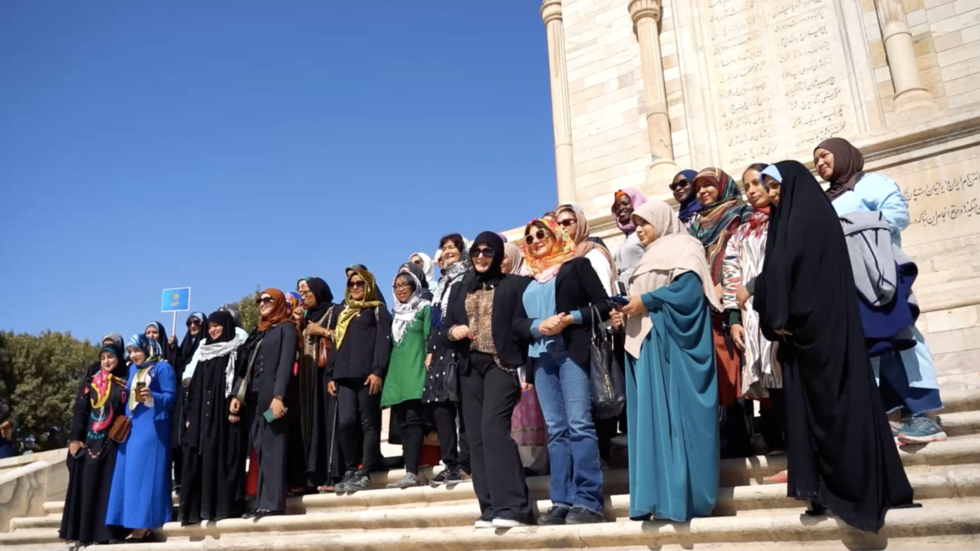
An American journalist recounts her experience in the Islamic nation and how it differs from pictures on Western screens
By Fiorella Isabel, journalist, geopolitical analyst, RT correspondent and host of independent talk show The Convo Couch. Follow Fiorella on X @FiorellaIsabelM
© Khorsheed Media Festival
One of the oldest and most culturally rich countries in West Asia, Iran holds relics of the rise and fall of empires of the past. Tehran, its capital and largest city, full of architectural wonders, has a population of 9.5 million.
But it is in Mashhad, a city in the northeast of the country, known as a place for religious pilgrimage, that I, along with over 100 other women in the media, attended the Khorsheed Media Festival, a festival sponsored by the local municipality as well as the Ministry of Culture and the bureau of the Iranian president’s deputy for women and family affairs. The aim was to connect women in journalism and expose them to the realities of Iran, especially, to the role of women in its society.
Woven among the streets of Tehran and Mashhad is where the noticeable differences between what Western media alleges about Iran and its treatment of women, versus the reality on the ground, became much clearer. According to Western media, women in Iran have little to no rights, and protests within Iran have erupted, with support from the US and other Western countries, calling for the freedom of these oppressed women.
These voices of opposition against Iran’s government grew louder after the case of Mahsa Amini, a 22-year-old woman who allegedly died in police custody from being brutally beaten by the so-called morality police for not adhering to the dress code. Police denied they had ever touched her or even made an arrest. The president of Iran immediately called for an investigation and lamented the death of the young woman. But the incident sparked a wave of protests across Iran, with many in the US demanding intervention and calling for the abolishment of the current government.
Read more
CCTV footage later revealed that after Amini and an officer exchanged words, she collapsed on her own before she was taken to the hospital where she later died. Further, forensics from a coroner’s report on Amini showed her death was not caused by a blow to the head, but by multiple organ failure caused by a lack of oxygen to the brain. It was also confirmed by medical professionals that she had a brain tumor and had previously gone to the hospital for treatment.
Having traveled to other countries labeled ‘brutal dictatorships’, where as an American I was told not to go, like Nicaragua, Cuba, Venezuela, and Russia, which ended up being far from the painted evil, I had a pretty keen idea that I would not be seeing exactly what the media claimed. But I was immediately more than shocked upon arriving at the airport in Tehran and seeing a woman with no headscarf in front of a police officer, getting into a vehicle without being harassed or even told to cover up. The surprises would keep coming in this realm as I saw women in cafes and streets not wearing the headscarf at all, and there was hardly even a glance from most. Although alcohol is banned in Iran, there was dancing, singing, and many families celebrating the weekend in a cafe, but there were also several women in the presence of men and their families not wearing a scarf.
Multiple sources had listed that a teenage woman Armita Geravand had died in Iran due to another beating by police, but she is actually in a coma. This is being weaponized once again to blame the government & push for regime change, even with CCTV footage showing otherwise. The… pic.twitter.com/sdlTYZPocO
— Fiorella Isabel (@FiorellaIsabelM) October 7, 2023
Even more than the issue of the hijab or headscarf, women in Iran are statistically well-educated, with over 57 percent of women in higher education as of 2020, and that’s exactly what I witnessed among a bevy of lawyers, doctors, professors, scientists, and key members of Iranian society. In fact, female adult literacy rates tripled from 24% in 1976 near the end of the Iranian monarchy to 81% in 2016, while those who finished primary education increased from 36% in 1971 to 99% in 2017. Not only were Iranian women highly educated, the men were supportive of their endeavors in addressing the issues they felt most needed attention. The women seemed to run the show, especially focusing on the Western propaganda waged against Iran, and how they are leading the charge in fighting it.
© Khabar 24 / Amir Ali Sattarpour
From what I witnessed, women in Iran enjoy higher stature in the family home compared to their Western counterparts. I joined women from Algeria, Turkey, and Kenya to relay our experience on Press TV, and though we did not know each other, we all had similar observations when recounting what we saw versus what we had been told we would see. The difference in how women view themselves in Iran versus the West lies in how they view gender roles. In the West, feminism has merged with the idea of sexual expression and being able to do anything a man can do. But in Iran, women are treated in a delicate manner and praised as essential members of society with different roles than men, but the differences are valued rather than opposed.
Some of us also had the opportunity to meet with President Ebrahim Raisi, who gave a speech mentioning how “the West uses women as a tool” and are not really in favor of human or women’s rights, but use both to exert pressure on independent nations. He added that “The Islamic Republic views women as neither an instrument, nor a homemaker. In a sense, there is a third view which observes that women can be society builders alongside men and play an essential role in the family and society.”
© Fiorella Isabel
He further criticized the West for disregarding the human rights of the Palestinian people for seven decades and for occupying Afghanistan for 20 years, leaving behind only chaos and damage.
Still, the narrative in the West remains the same a little over a year after Mahsa Amini’s death. Most recently, a supposed attack on another young woman became a new catalyst for accusations against Iran’s government. According to Western media reports citing a prominent Kurdish group, 16-year-old Armita Geravand went into a coma after suffering “severe physical assault” at the hands of government police inside a metro. Similarly to Amini’s case, police denied they had anything to do with her death and released CCTV footage showing the young woman arriving at Shahada Metro, entering the train, and later being carried out by her friends. The parents confirmed this, saying she suffered a drop in blood pressure and fainted, hitting her head on the edge of the door, after which she was taken to the hospital by her friends who had called an ambulance. Even more compelling are the statements to the media by the friends who had accompanied Geravand, saying no one had attacked or approached them. But that didn’t stop Western media from running with the story of how she had been allegedly “beaten into a coma.” Iran’s spokesperson for the Ministry of Foreign Affairs criticized US, UK, and German officials for their remarks on Geravand’s case and women’s rights, saying, “Instead of interventionist and biased remarks and expressing insincere concern over Iranian women and girls, you’d better be concerned about US, German and UK healthcare personnel, patients and tackle their situation.”
Read more
While there are surely protests and anti-government sentiments, the women I encountered and saw in the streets appeared to wear the headscarf because they wanted to and told me they did not feel “oppressed” but were trying to fight the propaganda about women in Iran. The West Asian nation is a theocratic state but that does not mean that women do not have value. Instead, vast cultural differences mean different definitions of freedom. One university instructor and filmmaker with a Master’s degree named Sheida told me, “Western media deliberately do not mention examples of justice for women in the Islamic Republic of Iran. Of course, they see it, but they pretend not to see it.” According to her, the Islamic Revolution gave value to women, and Iranian Muslim and non-Muslim women are no longer commodities to be chosen for their bodies, allowing women in scientific and cultural fields, military, sports, and politics to play a great role and have a great impact on the development of the country. Their sexuality has not hindered their abilities like it does in the West.
I also had the chance to speak at a panel on precisely the history of US interventions all over the world, where I outlined the mechanisms used by the West to overthrow leaders who do not agree with their foreign policy. I mentioned how the US has done anything but live up to its ideals of truth and freedom, while Western claims of ‘democracy’ have come in the form of deceit, intervention, and war for the rest of the world. And whether I or any foreigner disagrees with Islam, our opinions about these Muslim women or the government of Iran is irrelevant. Iran is a sovereign country and its people have a right to decide for themselves, without the exploitation of ‘humanitarian’ ideals covering an ugly desire for intervention and political expediency.
The statements, views and opinions expressed in this column are solely those of the author and do not necessarily represent those of RT.




